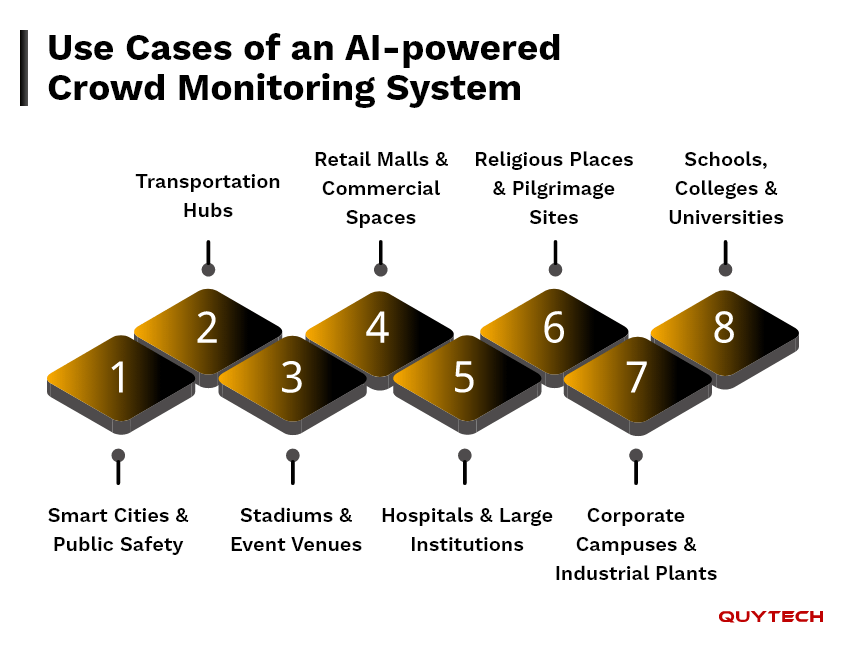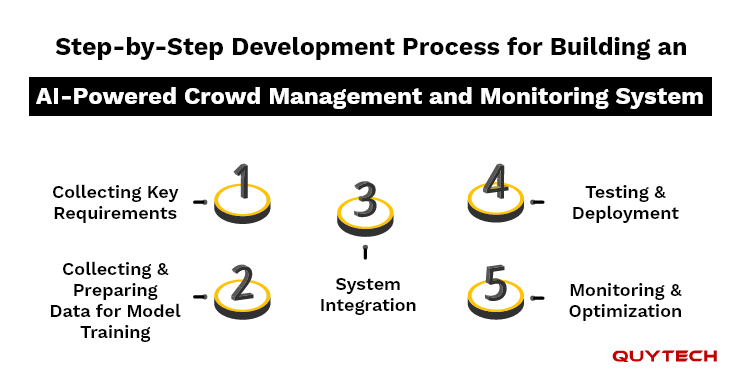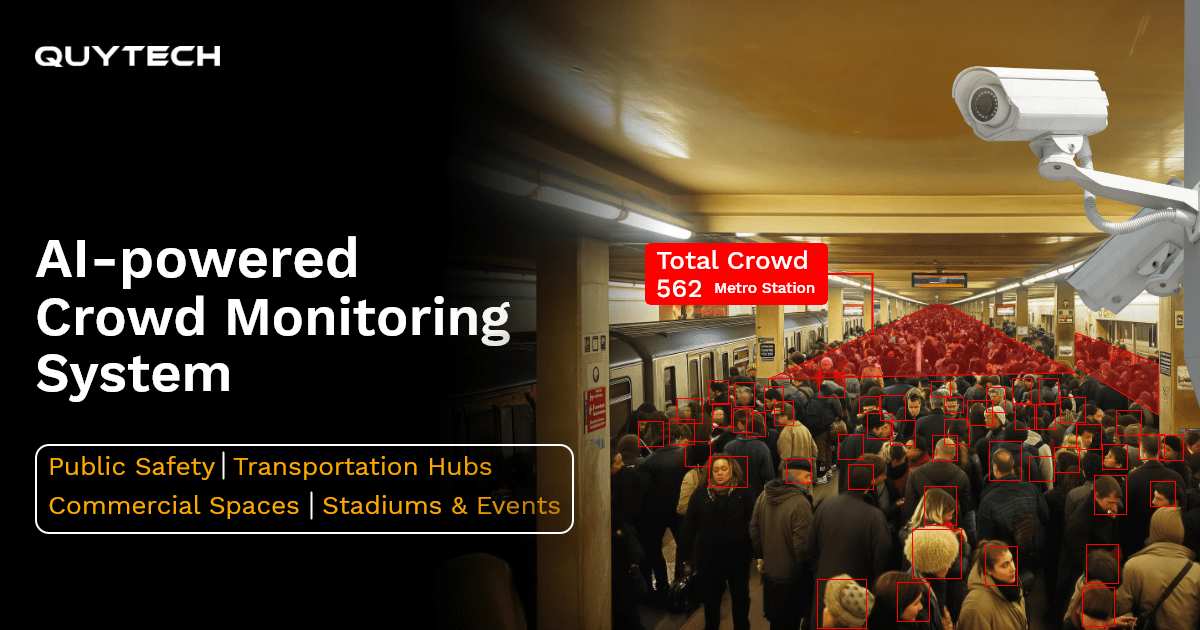Managing and monitoring crowds in large gatherings, bustling city centers, popular tourist destinations, and vibrant event venues is no easy feat. The world has already witnessed many such incidents where poor crowd monitoring and management have led to serious injuries, panic, and even loss of lives.
These incidents are proof that traditional ways of managing and monitoring people no longer work. We direly need a real-time crowd monitoring system that is smart enough to ensure the smooth flow of people to prevent congestion and maintain safety, and offers constant and intelligent monitoring to facilitate quick decision-making.
That’s why the demand for AI-powered crowd monitoring systems is skyrocketing. Whether it is a retail or shopping mall, sports stadiums, event organizing venues, transportation hubs, educational institutions, religious places, or theme parks, a real-time crowd monitoring system is a must for every place or business that deals with a large number of people.
If you wish to build such an intelligent crowd monitoring system or software to meet the growing demand and grab a competitive edge, you are in the right place. The blog helps you explore everything, including the core capabilities and working of an AI-powered crowd surveillance system, its benefits, use cases, features, and the stepwise development process.
What is an AI-Powered Crowd Monitoring System
An AI-powered crowd surveillance system is an intelligent system that leverages AI, ML, and computer vision to analyze crowd behavior, density, flow, and other critical parameters in real-time.
It goes beyond traditional monitoring, which only shows the crowd and records the footage for later analysis, and analyzes the feed in real-time to assess risk, and triggers alerts to relevant authorities.
Difference Between Traditional and AI-Based Crowd Monitoring Software
Let’s understand the difference between conventional and artificial intelligence-powered crowd monitoring systems in a tabular form:
| Parameters | Traditional Crowd Monitoring | AI-Based Crowd Monitoring System |
| Monitoring Method | Manual observation via CCTV | Automated and real-time analysis using AI |
| Accuracy | Chances of errors and oversight | High accuracy with the system capable of self learning |
| Response Time | Time-intensive, based on the time when human analysis completes | Instant alerts based on predefined rules |
| Scalability | Depends on the number of personnel | Seamlessly scalable across multiple locations |
| Data Utilization | Limited or no insights | Provides actionable insights from crowd data analysis |
| Cost Efficiency | High operational costs; increase when more resources are needed for analysis. | Long-term savings through automation |
Use Cases of an AI-powered Crowd Monitoring System
This section covers how an AI crowd monitoring system transforms the way various organizations and management teams of public and private organizations manage crowds to avoid unwanted incidents:

- Smart Cities and Public Safety
With a crowd management system, government organizations and authorities can monitor public spaces like markets, metro stations, festivals, and streets. The system can detect overcrowding and panic movement for smooth management of crowd flow and rapid response to critical situations. For this, the system relies on Edge AI cameras that facilitate real-time density estimation, heat mapping, anomaly detection, and integration with public CCTV cameras.
Learn More: AI-Powered Video Analytics for Public Sector
- Transportation Hubs
An artificial intelligence-powered crowd detection and monitoring system can be used at airports, bus terminals, railway stations, ferry terminals, and other locations to manage passenger flow via security checkpoints and boarding gates. It can alert the authorities in case a specific area gets overcrowded and requires intervention from the authorities for better management. For this, the system uses computer vision to count people, deep learning for crowd flow analysis, and integration with access control systems.
Also Read: AI for Smart Traffic Management: Reducing Congestion and Accidents
- Stadiums and Event Venues
The crowd monitoring and management system can be used during live concerts, sports events, political rallies, and other similar events to track crowd movements, density, and behavior in real-time. It can even detect unusual activities like fights and alert security personnel for immediate response/action. For this, the system uses movement pattern analysis, real-time behavior detection, and integration with public address systems.
- Retail Malls & Commercial Spaces
Retailers and commercial space managers can utilize AI-powered crowd monitoring to analyze foot traffic, customer flow, and occupancy across different floors and stores. Using the insights generated by the crowd management system, they can efficiently manage queues, ensure tight security, and optimize store layouts. To facilitate this, the AI-powered smart crowd management system utilizes heatmaps and congestion detection, facial recognition, and predictive analytics.
Also Read: AI Video Analytics in Retail: CCTV Security Solution
- Hospitals and Large Institutions
One of the common applications of AI crowd management systems is to provide insights on the movement of patients, visitors, and staff at a hospital or large institution. Healthcare facilities can even use this for monitoring specific areas, such as emergency rooms, OPDs, and others. The system leverages people counting and zone-based crowd control and compliance monitoring for accurate analysis and output.
You might be interested in: How to Develop a Patient Record Management System?
- Religious Places & Pilgrimage Sites
Implementing smart crowd monitoring at religious places and pilgrimage sites can help authorities handle massive crowds during rituals and festivals. Efficient crowd management can prevent congestion, panic, and even incidents like stampedes. The monitoring system uses real-time people density tracking, entry-exit flow analytics, and integration with drones to offer precise analysis and output.
- Corporate Campuses & Industrial Plants
Giant organizations and factories can leverage intelligent crowd monitoring to monitor workforce movements in assembly lines, exits, cafeterias, and other areas. Based on the analysis and insights, they can efficiently manage shifts and plan emergency evacuations. Zone-based occupancy monitoring, schedule-based crowd prediction, and integration with the badge-in systems are what a crowd monitoring software requires to serve its purpose.
- Schools, Colleges & Universities
Educational institutions can utilize AI-powered crowd monitoring to manage students’ movement during entry, break hours, and campus events. With this, they can ensure safety and efficiently plan large gatherings like inter-college sports events or fests. The system flow analysis, integration with the student IDs management system, and CCTVs equipped across the campus.
You may also like: Use of AI in CCTV Monitoring: Top Use Cases
Core Technologies that Work Behind an AI-Based Crowd Monitoring System
Apart from artificial intelligence, it requires a number of other technologies to work together for the successful functioning of a smart crowd management or monitoring system. Let’s find out more about them:
Computer Vision
The technology equips the system with exceptional capabilities of seeing and understanding the video feeds like human beings, with a considerable difference in speed and accuracy. With computer vision, the crowd surveillance solution can detect and track people, identify crowd density, and analyze movement patterns in real-time.
For instance, in a shopping mall, computer vision-powered crowd control artificial intelligence systems can count the number of people in different zones. It can also raise an alarm if any of the areas gets overcrowded.
Deep Learning and Neural Networks
By embedding deep learning models and CNN (convolutional neural networks), the AI crowd monitoring systems can easily recognize human behavior, like unusual gathering, panic movement, or sudden running.
For instance, deep learning enables a crowd control AI system to detect chaotic movement in the stands or a particular spot of a stadium. It raises an alarm to relevant authorities to prevent potential panic or the chances of a stampede.
Similar Read: Suspicious Behavior Detection Systems in Banks: Complete Development Guide
Machine Learning
Machine learning equips the intelligent crowd surveillance system with the strength of automatically learning from past patterns and crowd behavior. It keeps on improving its ability to analyze the visual data for better and more accurate outcomes.
For instance, in a pilgrimage site, the smart crowd management system leverages machine learning to learn weekend or festive footfall patterns. It can automatically raise an alert in case of a sudden increase in the crowd.
Edge AI
As the name suggests, Edge AI means processing or analyzing live video footage on the edge of a camera for speed and real-time decision-making. It eliminates the AI crowd monitoring system’s constant requirement for cloud connectivity.
For example, an AI-enabled crowd monitoring system implemented at an airport terminal can detect people gathering at a check-in counter without waiting for cloud processing.
IoT
The Internet of Things technology makes a smart crowd surveillance system seamlessly integrate with existing CCTV infrastructure, drones, and IoT sensors to offer a bird’s-eye view of the crowd.
For instance, A smart crowd monitoring solution integrated with a security surveillance system at a large event can get real-time aerial footage from drones and analyze crowd density via IoT sensors.
Cloud Computing
Cloud computing is another technology that plays a vital role in the development of a crowd monitoring system. It facilitates the processing of visual data and running AI models on centralized cloud servers with high computational power and next-level data storage and security.
For example, a cloud-powered crowd monitoring system can help collect and analyze real-time visual data across multiple branches of a shopping mall or brand.
Step-by-Step Development Process for Building an AI-Powered Crowd Management and Monitoring System
For the successful development of a smart crowd management system, it is imperative that you follow the right steps for development. Therefore, follow the steps below for the development, or simply connect with a reputable and highly experienced AI video analytics system development company.

Step 1: Collecting Key Requirements
Like in the case of almost every software development, creating a smart crowd monitoring system also begins with understanding the key project requirements. It includes the kind of monitoring required, existing tech infrastructure, features, and particular use cases with detection thresholds. Based on this, build a development roadmap.
Step 2: Collecting and Preparing Data for Model Training
Define the sources of data collection, annotate the footage to identify crowd density, flow, and behavior, along with anomaly detection. Create new custom AI models or utilize existing ones and train them on the prepared datasets and in various lighting and environmental conditions. Once done, verify that the model serves its purpose efficiently and accurately.
Step 3: System Integration
Integrate the AI model with CCTV/IP cameras, drones, or other video sources and alert systems, dashboards, or third-party messaging apps. Don’t forget to ensure the compatibility of these systems with current video management systems.
Step 4: Testing and Deployment
Conduct rigorous tests by running the system in a simulated crowded environment and testing its accuracy and responsiveness. Fine-tune the model, if required. Deploy the system across the required areas or zones.
Step 5: Monitoring and Optimization
Regularly monitor the system for any glitches. Upgrade it with new features to extend its capabilities and seamlessly adapt to new environments, lighting, or crowd patterns. Apart from this, analyze AI models for their performance.
Key Features of an Intelligent Crowd Monitoring System
Before you build an intelligent system for crowd monitoring and management in small buildings, transportation hubs, stadiums, event venues, and others, it is critical to get an idea of the features it offers:
- Real-time People Counting
AI crowd management software has pre-equipped AI algorithms that can count the number of individuals entering, present, and existing in a specific location or area. It can provide an accurate output by counting the number of people in real-time. Based on the data, crowd management teams can efficiently manage space and resources.
- Crowd Density Management
An intelligent people monitoring system can efficiently measure how tightly packed individuals are in a particular area. It can even send an overcrowding alert immediately if the crowd remains the same beyond safe thresholds. This can help authorities to avoid incidents like a crowd crush.
- Movement Tracking and Flow Analysis
It’s a critical feature of an AI-enabled crowd monitoring system. The feature makes the system capable of tracking the number of people that have moved through a space, say a check-in counter. The system then identifies high-traffic areas and unusual movement patterns to plan crowd management accordingly.
- Anomaly Detection
An advanced people monitoring system can detect irregular or erratic movement patterns, which may be a sign of panic, running, or sudden clustering of people. It raises an alert among security personnel to quickly intervene and take necessary action.
- Heat Mapping and Zone-Based Analysis
Heat mapping and zone-based analysis help with optimizing store layout, managing crowd flow, and enhancing crowd experiences in public spaces like shopping malls and others.
Benefits of an Intelligent Crowd Monitoring System
From bolstering public safety and proactive crowd control to optimal resource allocation, data-driven crowd management, and regulatory compliance adherence, a smart people monitoring software offers immense benefits. Explore them in detail:
- Enhanced Public Safety
Artificial intelligence-powered crowd monitoring software can detect early signs of overcrowding, potential panics, and abnormal crowd movements to enable authorities to take action and prevent stampedes, crowd crushes, and other similar incidents.
- Proactive Crowd Control
Using such a system enables event organizers and security authorities to adopt a proactive approach to manage and control crowds before they become unmanageable. It also facilitates real-time intervention by triggering an alert right when it detects that the defined thresholds are crossed.
- Data-Driven Planning and Resource Allocation
This is one of the most amazing advantages of an AI-based crowd monitoring system. With crowd analytics, generated by monitoring and analyzing crowd behavior in real-time, security authorities can understand footfall trends, peak times, and crowd flow patterns. They can optimize staffing, design store layouts, and plan efficiently for any unwanted situation.
- Improved Operational Efficiency
Automated crowd monitoring eliminates the requirement of constant manual observation. It also eliminates the chances of human errors while enabling security teams to focus on rapid dispatch or action taking in case of an emergency.
- Regulatory Compliance and Reporting
Many public spaces have limitations when it comes to allowing entry to individuals. AI-based crowd surveillance systems can ensure compliance with those rules by analyzing density and movement patterns. This also makes reporting quick and precise.
- Better Visitor Experience
Implementing an AI crowd monitoring system allows authorities to manage crowd flow in a manner to give visitors a smoother and less congested experience at public events, transportation hubs, and other places.
How Quytech Can Help
Quytech is a reputed technology company with in-depth expertise in building AI-powered video analytics and crowd analytics solutions that serve diverse use cases. Whether you want an AI-powered crowd analytics solution for airports, retail, event management, or healthcare facilities, we can build it to help you enhance people safety, real-time people counting, efficient crowd management, and rapidly respond to emergency situations.
The AI camera solutions we develop can be integrated with existing cameras and security surveillance systems. Our AI experts have built fire detection systems, accident detection systems, fall detection systems, car damage detection systems, suspicious behavior detection systems, and other video analytics solutions for retail, public sector, and other industries to help them transform operations management and safety.
Final Thoughts
With the increasing number of incidents that happen due to poor crowd management and monitoring, the need for AI smart crowd monitoring systems is at an all-time high. These systems can help detect overcrowding, track crowd movement patterns, and provide real-time insights on crowd density and unusual behavior to alert authorities to take immediate action.
A crowd monitoring system utilizes technologies like AI, computer vision, deep learning, and machine learning to ensure people’s safety, better crowd management, and make data-driven decisions. Read this blog to learn more about the system, its benefits, development process, features, and other crucial aspects.
FAQs
The cost of developing a crowd management system powered by AI depends on various factors, including the complexity, number of locations, features, and integration requirements. Reach out to one of the experts at Quytech with your custom requirements to get an accurate estimate.
These are the best practices to build a successful crowd surveillance system:
– Use high-quality and diverse data for model training
– Make your system scalable
– Don’t ignore privacy compliance and accuracy
– Choose an experienced technology partner
– Continuously upgrade the system with new features
– Provide a provision with which the AI models can regularly train themselves on new data for better performance
The use cases or applications of an AI-powered crowd monitoring system have been thoroughly explained in this blog. It could be used in smart cities and public safety, airports and transportation hubs, stadiums and event venues, retail malls and commercial spaces, and hospitals and large institutions.
Transportation, event management, retail, government, and healthcare are some of the sectors that can take advantage of a system facilitating smart crowd management.
When you build a crowd management system, you may encounter data privacy problems, lighting and weather conditions-related difficulties, inability to scale, and issues in integrating the system with existing technology infrastructure. Choose the right partner for developing such a system to avoid these problems.



